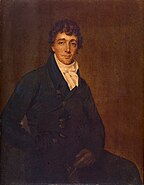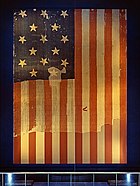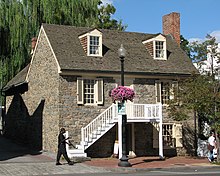
Francis Scott Key was an American lawyer, author, and poet from Frederick, Maryland, best known as the author of the text of the American national anthem "The Star-Spangled Banner". Key observed the British bombardment of Fort McHenry in 1814 during the War of 1812. He was inspired upon seeing the American flag still flying over the fort at dawn and wrote the poem "Defence of Fort M'Henry"; it was published within a week with the suggested tune of the popular song "To Anacreon in Heaven". The song with Key's lyrics became known as "The Star-Spangled Banner" and slowly gained in popularity as an unofficial anthem, finally achieving official status as the national anthem more than a century later under President Herbert Hoover.

"The Star-Spangled Banner" is the national anthem of the United States. The lyrics come from the "Defence of Fort M'Henry", a poem written by American lawyer Francis Scott Key on September 14, 1814, after he witnessed the bombardment of Fort McHenry by the British Royal Navy during the Battle of Baltimore in the War of 1812. Key was inspired by the large U.S. flag, with 15 stars and 15 stripes, known as the Star-Spangled Banner, flying triumphantly above the fort after the battle.

Rock Creek Park is a large urban park that bisects the Northwest quadrant of Washington, D.C. Created by Act of Congress in 1890, the park comprises 1,754 acres, generally along Rock Creek, a tributary of the Potomac River.

The National Mall is a landscaped park near the downtown area of Washington, D.C., the capital city of the United States. It contains and borders a number of museums of the Smithsonian Institution, art galleries, cultural institutions, and various memorials, sculptures, and statues. It is administered by the National Park Service (NPS) of the United States Department of the Interior as part of the National Mall and Memorial Parks unit of the National Park System. The park receives approximately 24 million visitors each year.

Georgetown is a historic neighborhood and commercial district in Northwest Washington, D.C., situated along the Potomac River. Founded in 1751 as part of the colonial-era Province of Maryland, Georgetown predated the establishment of Washington, D.C. by 40 years. Georgetown was an independent municipality until 1871 when the United States Congress created a new consolidated government for the entire District of Columbia. A separate act, passed in 1895, repealed Georgetown's remaining local ordinances and renamed Georgetown's streets to conform with those in Washington, D.C..

Fort McHenry is a historical American coastal pentagonal bastion fort on Locust Point, now a neighborhood of Baltimore, Maryland. It is best known for its role in the War of 1812, when it successfully defended Baltimore Harbor from an attack by the British navy from Chesapeake Bay on September 13–14, 1814.

Rosslyn is a heavily urbanized unincorporated area in Northern Virginia located in the northeastern corner of Arlington County, Virginia, north of Arlington National Cemetery and directly across the Potomac River from Georgetown and Foggy Bottom in Washington, D.C.

The Chesapeake and Ohio Canal National Historical Park is located in the District of Columbia and the state of Maryland. The park was established in 1961 as a National Monument by President Dwight D. Eisenhower to preserve the neglected remains of the Chesapeake and Ohio Canal and many of its original structures.
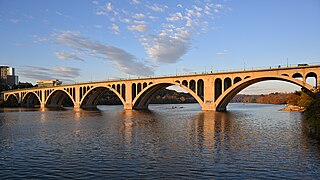
The Francis Scott Key Bridge, more commonly known as the Key Bridge, is a six-lane reinforced concrete arch bridge carrying U.S. Route 29 (US 29) across the Potomac River between the Rosslyn neighborhood of Arlington County, Virginia, and the Georgetown neighborhood of Washington, D.C. Completed in 1923, it is Washington's oldest surviving road bridge across the Potomac River.

The Mount Vernon Trail (MVT) is an 18-mile (29 km) long shared use path that travels along the George Washington Memorial Parkway in Northern Virginia between Rosslyn and George Washington's home at Mount Vernon. The trail connects the easternmost portions of Arlington County, the City of Alexandria, and Fairfax County, and travels mostly on dedicated trail with a small portion on city streets. As part of U.S. Bike Route 1, the Potomac Heritage Trail and the East Coast Greenway, the MVT opened in April 1972 as a gravel path and was subsequently expanded and paved.

Buildings, sites, districts, and objects in Virginia listed on the National Register of Historic Places:

Scott Circle is an area in the northwest quadrant of Washington, D.C. that is centred on the junction of Massachusetts Avenue, Rhode Island Avenue, and 16th Street, N.W. Originally a neighborhood recreational area like nearby Dupont Circle, Scott has lost all social uses except as the location for public memorials.

Hamilton Grange National Memorial is a historic house museum within St. Nicholas Park in the Hamilton Heights neighborhood of Manhattan in New York City. Operated by the National Park Service (NPS), the structure was the only home ever owned by the U.S. founding father Alexander Hamilton. The house contains exhibits for visitors, as well as various rooms with restored 19th-century interiors. Originally located near present-day 143rd Street, the house was moved in 1889 to 287 Convent Avenue before being relocated again in 2008 to St. Nicholas Park. The structure is a New York City designated landmark and a United States national memorial, and it is listed on the National Register of Historic Places.

The Aqueduct Bridge, also called the Alexandria Aqueduct, was a bridge that carried traffic between Georgetown, Washington, D.C., and Rosslyn, Virginia, from 1843 to 1923.
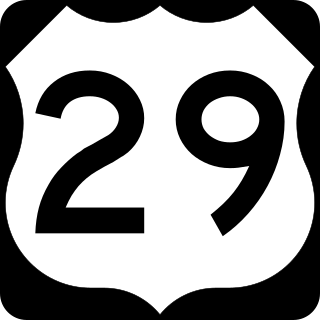
U.S. Route 29 (US 29) enters Washington, D.C., via the Key Bridge from Arlington County, Virginia, and exits at Silver Spring, Maryland. It predominantly follows city surface streets, although the portion of the route from the Key Bridge east to 26th Street Northwest is an elevated highway better known as the Whitehurst Freeway. The freeway, called the city's most ridiculed bridge in 1989, has survived several proposals for its demolition.
The Holliday Street Theater also known as the New Theatre, New Holliday, Old Holliday, The Baltimore Theatre, and Old Drury, was a historical theatrical venue in Federal Period Baltimore, Maryland. It is known for showing the first performance of Francis Scott Key's "The Star-Spangled Banner".

Paul Johannes Pelz was a German-American architect, best known as the main architect of the Library of Congress in Washington DC.

The Lockkeeper's House is the oldest building on the National Mall in Washington, D.C. It was built in 1837 at what is now the southwest corner of 17th Street, NW and Constitution Avenue, NW, near Constitution Gardens.

Glover Archbold Park is a 183-acre quasi-natural, stream-valley park in Northwest Washington, D.C., on the western edge of Georgetown University and adjacent to the Burleith-Hillandale, Glover Park, McLean Gardens, and Westchester neighborhoods. One of the "finger parks" of Rock Creek Park, the Glover-Archbold Park is administered by the National Park Service (NPS).

Francis Scott Key Memorial is a park and memorial located in the District of Columbia neighborhood of Georgetown; at the intersection of 34th and M Streets, NW. This 0.77 acre site is administered by the National Park Service as a part of Rock Creek Park but is not contiguous with that park. Situated adjacent to the northeast corner of the Francis Scott Key Bridge, the park abuts to Chesapeake and Ohio Canal Towpath.

